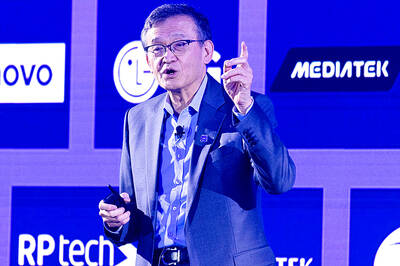Pan Asia Bank (泛亞銀行) yesterday forged a strategic partnership with the US-based GMAC Commercial Mortgage Corp (GMACCM) to develop business opportunities in the nation's nascent securitization market.
Pan Asia chairman Victor Liu (劉維琪) yesterday said that GMACCM, which is a subsidiary of GMAC Commercial Holding Corp -- one of the global arms of General Motors Corp -- has put down an investment of NT$1.5 billion in the preferred shares of Pan Asia by taking up a 14.2 percent stake.
In return, Pan Asia will invite two GMACCM members to sit in its board of directors as special advisors for the next five years before its preferred shares are transformed into ordinary shares, Liu added.
"We'd like to take advantage of GMACCM's financial expertise to build up Pan Asia's competitiveness in the corporate-lending business and other fee income-based transactions," Liu said at a signing ceremony yesterday afternoon to officially announce the partnership.
Lauding the affiliation, GMAC Commercial Holding Corp president Scot Baker said in a pre-recorded speech played during the ceremony that Pan Asia's "deep knowledge of the local market, diversification of financial product, distribution of connections and its loyal customer base" were behind his company's decision to form a partnership with the local lender even though the bank suffered an after-tax loss of NT$1.34 billion in 2002.
After the NT$1.5 billion investment is secured, Pan Asia will be able to facilitate its total of NT$2.3 billion recapitalization plan, which will help increase the bank's capital adequacy ratio (BIS ratio) to meet the government's set 8 percent
requirement.
Pan Asia, however, is still posting a bad-loan ratio of 33 percent, or over NT$40 billion in non-performing loans (NPLs).
Liu refused to elaborate yesterday on the bank's write-off plans.
But he expressed hope that Pan Asia's affiliation with GMACCM will also focus on the bank's write-off of its NPLs.
Pan Asia will cooperate with GMACCM to tap into the nation's asset-based securitization market, NPL lending and real estate non-recourse financing services, Liu said.
He estimates that the size of the local non-recourse financing market may hit NT$100 billion.
Expressing its full commitment to Taiwan's markets, GMACCM chief executive officer and president Steve Lin (林至文) said yesterday that his company is confident about the long-term prospects for the local economy and real-estate market.
To reinforce its local operations, Lin said that the company has increased the number of its Taiwan-based staff from two to 25 in Taipei and Kaohsiung.
As the largest securitization player in Japan, he also said that the company is also very interested in taking part in Taiwan's nascent securitization market backed by properties and mortgage loans because the government is committed to fully liberalize and further restructure the local banking sector.
In addition, GMACCM plans to leverage its partnership with Pan Asia as a springboard to tap into the greater China markets by cultivating bilingual financial personnel who are familiar with local markets, Lin said.
Meanwhile, Liu said, Pan Asia is planning to change its name as Bowa Bank (

The Eurovision Song Contest has seen a surge in punter interest at the bookmakers, becoming a major betting event, experts said ahead of last night’s giant glamfest in Basel. “Eurovision has quietly become one of the biggest betting events of the year,” said Tomi Huttunen, senior manager of the Online Computer Finland (OCS) betting and casino platform. Betting sites have long been used to gauge which way voters might be leaning ahead of the world’s biggest televised live music event. However, bookmakers highlight a huge increase in engagement in recent years — and this year in particular. “We’ve already passed 2023’s total activity and

Nvidia Corp CEO Jensen Huang (黃仁勳) today announced that his company has selected "Beitou Shilin" in Taipei for its new Taiwan office, called Nvidia Constellation, putting an end to months of speculation. Industry sources have said that the tech giant has been eyeing the Beitou Shilin Science Park as the site of its new overseas headquarters, and speculated that the new headquarters would be built on two plots of land designated as "T17" and "T18," which span 3.89 hectares in the park. "I think it's time for us to reveal one of the largest products we've ever built," Huang said near the

China yesterday announced anti-dumping duties as high as 74.9 percent on imports of polyoxymethylene (POM) copolymers, a type of engineering plastic, from Taiwan, the US, the EU and Japan. The Chinese Ministry of Commerce’s findings conclude a probe launched in May last year, shortly after the US sharply increased tariffs on Chinese electric vehicles, computer chips and other imports. POM copolymers can partially replace metals such as copper and zinc, and have various applications, including in auto parts, electronics and medical equipment, the Chinese ministry has said. In January, it said initial investigations had determined that dumping was taking place, and implemented preliminary

Intel Corp yesterday reinforced its determination to strengthen its partnerships with Taiwan’s ecosystem partners including original-electronic-manufacturing (OEM) companies such as Hon Hai Precision Industry Co (鴻海精密) and chipmaker United Microelectronics Corp (UMC, 聯電). “Tonight marks a new beginning. We renew our new partnership with Taiwan ecosystem,” Intel new chief executive officer Tan Lip-bu (陳立武) said at a dinner with representatives from the company’s local partners, celebrating the 40th anniversary of the US chip giant’s presence in Taiwan. Tan took the reins at Intel six weeks ago aiming to reform the chipmaker and revive its past glory. This is the first time Tan